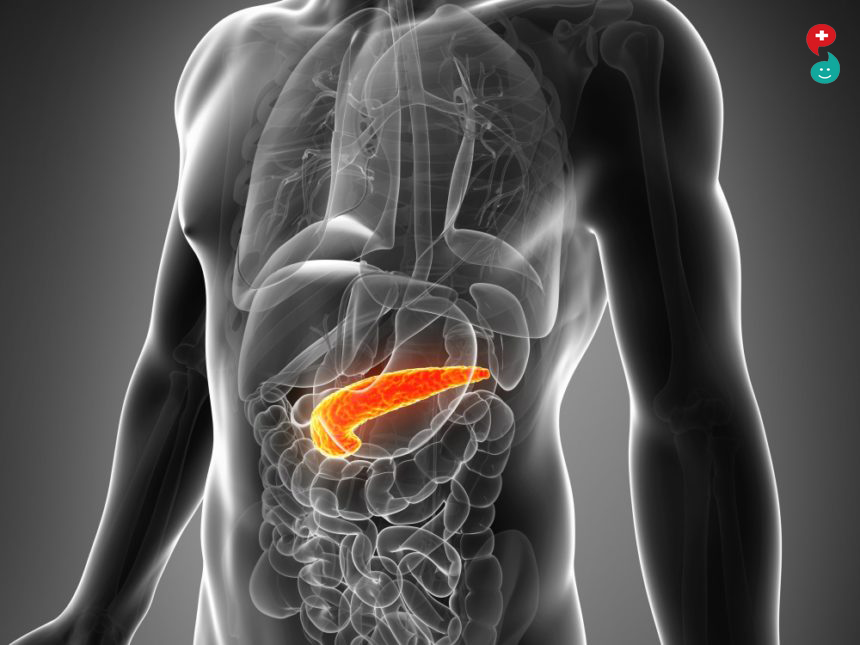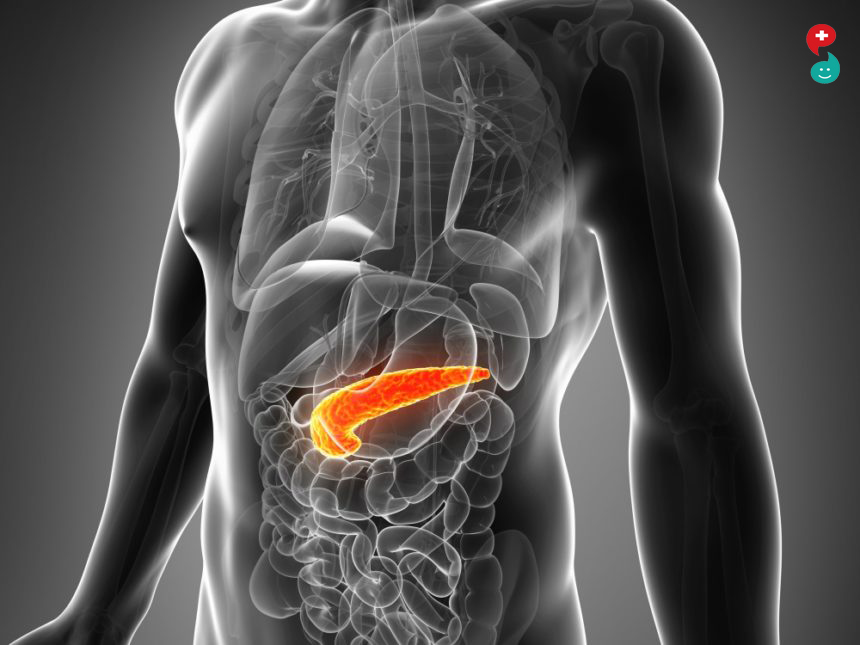Pancreatic cancer begins in the tissues of your pancreas — an organ in your abdomen that lies horizontally behind the lower part of your stomach. Your pancreas releases enzymes that aid digestion and hormones that help manage your blood sugar.
Pancreatic cancer typically spreads rapidly to nearby organs. It is seldom detected in its early stages. But for people with pancreatic cysts or a family history of pancreatic cancer, some screening steps might help detect a problem early. One sign of pancreatic cancer is diabetes, especially when it occurs with weight loss, jaundice or pain in the upper abdomen that spreads to the back.
Treatment may include surgery, chemotherapy, radiation therapy or a combination of these.
Symptoms
Signs and symptoms of pancreatic cancer often don't occur until the disease is advanced. They may include:
Pain in the upper abdomen that radiates to your back
Loss of appetite or unintended weight loss
Depression
New-onset diabetes
Blood clots
Fatigue
Yellowing of your skin and the whites of your eyes (jaundice)
When to see a doctor
See your doctor if you experience unexplained weight loss or if you have persistent fatigue, abdominal pain, jaundice, or other signs and symptoms that bother you. Many conditions can cause these symptoms, so your doctor may check for these conditions as well as for pancreatic cancer.
Causes
It's not clear what causes pancreatic cancer in most cases. Doctors have identified factors, such as smoking, that increase your risk of developing the disease.
Understanding your pancreas
Your pancreas is about 6 inches (15 centimeters) long and looks something like a pear lying on its side. It releases (secretes) hormones, including insulin, to help your body process sugar in the foods you eat. And it produces digestive juices to help your body digest food.
How pancreatic cancer forms
Pancreatic cancer occurs when cells in your pancreas develop mutations in their DNA. These mutations cause cells to grow uncontrollably and to continue living after normal cells would die. These accumulating cells can form a tumor. Untreated pancreatic cancer spreads to nearby organs and blood vessels.
Most pancreatic cancer begins in the cells that line the ducts of the pancreas. This type of cancer is called pancreatic adenocarcinoma or pancreatic exocrine cancer. Rarely, cancer can form in the hormone-producing cells or the neuroendocrine cells of the pancreas. These types of cancer are called islet cell tumors, pancreatic endocrine cancer and pancreatic neuroendocrine tumors.
Risk factors
Factors that may increase your risk of pancreatic cancer include:
Chronic inflammation of the pancreas (pancreatitis)
Diabetes
Family history of genetic syndromes that can increase cancer risk, including a BRCA2 gene mutation, Lynch syndrome and familial atypical mole-malignant melanoma (FAMMM) syndrome
Family history of pancreatic cancer
Smoking
Obesity
Older age, as most people are diagnosed after age 65
A large study demonstrated that the combination of smoking, long-standing diabetes and a poor diet increases the risk of pancreatic cancer beyond the risk of any one of these factors alone.
Complications
As pancreatic cancer progresses, it can cause complications such as:
Weight loss. A number of factors may cause weight loss in people with pancreatic cancer. The cancer itself may cause weight loss. Nausea and vomiting caused by cancer treatments or a tumor pressing on your stomach may make it difficult to eat. Or your body may have difficulty processing nutrients from food because your pancreas isn't making enough digestive juices.
Your doctor may recommend pancreatic enzyme supplements to aid in digestion. Try to maintain your weight by adding extra calories where you can and making mealtime as pleasant and relaxed as possible.
Jaundice. Pancreatic cancer that blocks the liver's bile duct can cause jaundice. Signs include yellow skin and eyes, dark-colored urine, and pale-colored stools. Jaundice usually occurs without abdominal pain.
Your doctor may recommend that a plastic or metal tube (stent) be placed inside the bile duct to hold it open. This is done with the help of a procedure called endoscopic retrograde cholangiopancreatography (ERCP). During ERCP an endoscope is passed down your throat, through your stomach and into the upper part of your small intestine. A dye is then injected into the pancreatic and bile ducts through a small hollow tube (catheter) that's passed through the endoscope. Finally, images are taken of the ducts.
Pain. A growing tumor may press on nerves in your abdomen, causing pain that can become severe. Pain medications can help you feel more comfortable. Radiation therapy might help stop tumor growth temporarily to give you some relief.
In severe cases, your doctor might recommend a procedure to inject alcohol into the nerves that control pain in your abdomen (celiac plexus block). This procedure stops the nerves from sending pain signals to your brain.
Bowel obstruction. Pancreatic cancer that grows into or presses on the first part of the small intestine (duodenum) can block the flow of digested food from your stomach into your intestines.
Your doctor may recommend a tube (stent) be placed in your small intestine to hold it open. Or surgery may be necessary to attach your stomach to a lower point in your intestines that isn't blocked by cancer.
Prevention
You may reduce your risk of pancreatic cancer if you:
Stop smoking. If you smoke, try to stop. Talk to your doctor about strategies to help you stop, including support groups, medications and nicotine replacement therapy. If you don't smoke, don't start.
Maintain a healthy weight. If you are at a healthy weight, work to maintain it. If you need to lose weight, aim for a slow, steady weight loss — 1 to 2 pounds (0.5 to 1 kilogram) a week. Combine daily exercise with a diet rich in vegetables, fruit and whole grains with smaller portions to help you lose weight.
Choose a healthy diet. A diet full of colorful fruits and vegetables and whole grains may help reduce your risk of cancer.
स्वादुपिंडाचा कर्करोग
स्वादुपिंडाचा कर्करोग समजून येण्यासाठीच वेळ लागतो, यासारखी अनेक उदाहरणे आहेत. खूपदा उशिरा निदान झाल्याने उपचार करता येत नाही व लवकरच रुग्ण दगावतो.आपल्या पोटात जठराच्या मागे स्वादुपिंड हा महत्त्वाचा अवयव असतो. तो पाचक रस व इन्सुलिन निर्माण करतो. पाचक रसाने अन्नपचनास मदत होते. इन्सुलिनमुळे साखरेचे प्रमाण योग्य ठेवले जाते व इन्सुलिन कमी झाल्यास डायबेटिस होतो. स्वादुपिंडालाही कर्करोगाची बाधा होऊ शकते. इतर कर्करोगांच्या मानाने हा कर्करोग लवकर पसरतो व रुग्ण त्या मानाने लवकर दगावतो. आज जगात सर्वसाधारणत: पाच लाख रुग्ण दरवर्षी या आजाराने मृत्यू पावतात. प्रगत उपचार पद्धती उपलब्ध असूनसुद्धा निदानानंतर फक्त पाच टक्के रुग्ण पाच वर्षांपर्यंत जगतात.
स्वादुपिंडाच्या कर्करोगाची लक्षणे :
प्राथमिक स्वरूपात या आजाराची फारशी लक्षणे नसतात, पण तो पुढे जातो तेव्हाच त्याची ती दिसू लागतात.
- पोटाच्या वरच्या भागात दुखणे व दुखणे पाठीत पसरणे.
- कावीळ होणे- या काविळीत सुरुवातीस काहीच दुखत नाही व पिवळटपणा वाढत जातो.
- भूक न लागण
- वजन कमी होणे
- नैराश्य जाणवणे
स्वादुपिंडाच्या कर्करोगाची कारणे
आपल्या स्वादुपिंडाच्या पेशींमध्ये जनुकीय बदल होऊन नॉर्मल पेशींचा मृत्यू होतो. कर्करोगाच्या पेशींचा प्रादुर्भाव होऊन गाठी निर्माण होतात. बरेचदा स्वादुपिंडाचा कर्करोग हा स्वादुपिंडाच्या नलिकेपासून होतो. स्वादुपिंडाचा कर्करोग होण्यास खालील गोष्टी प्रवृत्त होतात.
-‘धूम्रपान ’अतिवजन/ लठ्ठपणा
- स्वादुपिंड दाह असणारे रुग्ण व त्यांचे कुटुंबीय ’ कुटुंबामध्ये स्वादुपिंडाचा कर्करोग ’ साठ वर्षे व त्यापुढील वयाच्या व्यक्ती. पुरुषांना जास्त प्रमाणात. ’ श्वेतवर्णीय व्यक्तींना हा कर्करोग कमी प्रमाणात होतो ’ मधुमेह ’ कीटकनाशक आणि रसायनांचा संबंध
डॉक्टरांचा सल्ला कधी घ्यावा?
वजन कमी होते, भूक लागत नाही, पोटात दुखते व कावीळ वाढते तेव्हा डॉक्टरांचा त्वरित सल्ला घ्यावा. अशा लक्षणांची अनेक कारणे असतात. पण डॉक्टर तपासण्या करून योग्य तो सल्ला देतील.
कर्करोगाचे निदान व तपासण्या
- अल्ट्रा साऊंड किंवा सोनोग्राफी- स्वादुपिंडाच्या गाठी तसेच त्यामुळे झालेल्या पित्ताशयावरील परिणाम जाणून घेतला जातो.
- सीटी स्कॅन- यातून पोटात अजून कुठे गाठ आहे व कॅन्सर किती पसरला आहे हे समजते.
- एमआरआय- एमआरआय मशीननेही हा तपास करता येतो.
- Endoscopy with ERCP – – डॉक्टर एण्डोस्कोपी साठी एक पातळ रबरी नळी तोंडाद्वारे पोटात घालून लहान आतडय़ाचा तपास करतात. स्वादुपिंडाचा रस जिथे आतडय़ात येतो, तेथे गाठ असेल तर तिची बायप्सीही घेता येते. बायप्सी म्हणजे एक छोटासा तुकडा काढून गाठींचे निदान करणे.
कावीळ जास्त प्रमाणात असेल तर या एण्डोस्कोपीतून एक नळी पित्तनलिकेत घालून कावीळ कमी करता येते. कावीळ कमी झाल्याने शस्त्रक्रियेचा धोका कमी होतो.
एण्डोस्कोपी शक्य नसल्यास- यकृतामध्ये सुई घालून एक नळी टाकली जाते (PTC) व त्यामधून पित्त काढले जाते. यामुळेही कावीळ कमी होते. याबरोबरच लॅप्रोस्कोपी (पोटाचा दुर्बिणीद्वारे तपास) छातीचा एक्सरे, PET Scan, हाडांचा स्कॅन (Bone Scan) तसेच इतर रक्तांच्या तपासण्या करून कर्करोग किती पसरला आहे हे कळते. सर्व तपासण्या झाल्यावर स्वादुपिंडाच्या कर्करोगाचे निदान केले जाते. त्याचे तीन वर्ग होतात.
१. काढून टाकण्याजोगा कर्करोग- कर्करोग कमी प्रमाणात असेल तर स्वादुपिंडाच्या कर्करोगग्रस्त भाग (बहुतांशी हेड) पूर्णपणे काढला जातो. त्याचबरोबर लहान आतडय़ांचा पहिला भाग पित्तनलिकाही काढावी लागते. यालाच व्हिपल्स ऑपरेशन्स (Whipples Operations) म्हणतात. हे ऑपरेशन कौशल्याने करावे लागते व यामध्ये जिवाला धोका असतो. परंतु हल्ली अनुभवाने व इतर साधनसोयींमुळे यात रुग्ण दगावण्याची शक्यता कमी झाली आहे. व्हिपल्स ऑपरेशन्स यशस्वी झाले तर रुग्ण काही वर्षे चांगला जगू शकतो.
२. आजूबाजूच्या अवयवांमध्ये पसरलेला कर्करोग. कर्करोग पसरला असेल तर शस्त्रक्रियेद्वारा किंवा एण्डोस्कोपीद्वारा पित्तनलिका व जठर हे आतडय़ास जोडून वेगळा मार्ग निर्माण करतात. त्याने कावीळ कमी होते. रुग्णास जेवता येते. परंतु अशा रुग्णांचे आयुष्य काही महिनेच असते.
३. दूरच्या अवयवांमध्ये पसरलेला कर्करोग. -हल्ली नवीन औषधे उपलब्ध झाल्याने काही प्रमाणात हा कर्करोग आटोक्यात आणता येतो. परंतु ही औषधे खूप महाग आहेत.
कर्करोगाचे परिणाम
- कावीळ, खाज येणे, लघवीचा रंग गडद होणे.
- पोटात व पाठीत दुखणे.
- आतडे अडकणे, उलटय़ा होणे, शौचास न होणे.
- वजन घटणे, मधुमेह होणे.
- रुग्ण दगावणे
- हा कर्करोग कसा टाळाल?
- धूम्रपान थांबवावे
- वजन प्रमाणात ठेवावे. हळूहळू (आठवडय़ाला अर्धा किलो) वजन कमी करावे.
- रोज तीस मिनिटे नियमित व्यायाम करावा.
- चांगला आहार- फळे, भाज्या व चपाती यांचा आहारामध्ये समावेश.
स्वादुपिंडाचा कर्करोग कमी जणांना होत असला तरी झाल्यावर तो उशिरा लक्षात येतो. निदान होईपर्यंत तो पसरलेला असतो. याची शस्त्रक्रिया ही गंभीर व धोक्याची असते. यामुळेच रुग्णाचे आयुष्य सीमित असते. बऱ्याचदा कावीळ झाल्यानंतर रुग्ण इतर उपाय करतात व डॉक्टरकडे जाण्याचे टाळतात. परंतु एक-दोन आठवडय़ांत कावीळ उतरली नाही तर तात्काळ डॉक्टरांकडे जाऊन तपास करणे आवश्यक असते.










